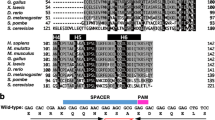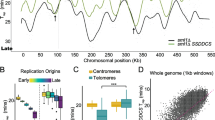Abstract
Human DNA polymerase iota (Pol ι) is a Y-family DNA polymerase with unusual biochemical properties and not fully understood functions. Pol ι preferentially incorporates dGTP opposite template thymine. This property can be used to monitor Pol ι activity in the presence of other DNA polymerases, e.g. in cell extracts of tissues and tumors. We have now confirmed the specificity and sensitivity of the method of Pol ι activity detection in cell extracts using an animal model of loach Misgurnus fossilis embryos transiently expressing human Pol ι. The overexpression of Pol ι was shown to be accompanied by an increase in abnormalities in development and the frequency of pycnotic nuclei in fish embryos. Further analysis of fish embryos with constitutive or regulated Pol ι expression may provide insights into Pol ι functions in vertebrate animals.



Similar content being viewed by others
References
Albertella MR, Lau A, O`Connor MJ (2005) The overexpression of specialized DNA polymerases in cancer. DNA Repair 4:583–593
Andreeva LE, Khaidarova NV, Sleptsova LA et al (2008) The effect of regulatory sequences of alphaS1-casein gene on the expression of the lacZ-gene in loach Misgurnus fossilis L. transgenic embryos. Genetika (Mosc) 44:992–999
Frank EG, Woodgate R (2007) Increased catalytic activity and altered fidelity of human DNA polymerase ι in the presence of manganese. J Biol Chem 282:24689–24696
Gening LV, Makarova AV, Malashenko AM et al (2006) A false note of DNA polymerase iota in the choir of genome caretakers in mammals. Biochemistry (Mosc) 71:155–159
Ishikawa T, Uematsu N, Mizukoshi T et al (2001) Mutagenic and non-mutagenic bypass of DNA lesions by Drosophila DNA polymerases dpol eta and dpol iota. J Biol Chem 276:15155–15163
Kazakov A, Gening LV, Grishina EE et al (2008) Balance activity alteration of DNA polymerases in some malignant tumors. Med. Genetics 7:32–39
Makarova AV, Grabow C, Gening LV et al (2011) Inaccurate DNA synthesis in cell extracts of yeast producing active human DNA polymerase iota. PLOS One 6:e16612
Petta TB, Nakajima S, Zlatanou A et al (2008) Human DNA polymerase iota protects cells against oxidative stress. EMBO J 27:2883–2895
Plosky BS, Frank EG, Berry DA et al (2008) Eukaryotic Y-family polymerases bypass a 3-methyl-2′-deoxyadenosine analog in vitro and methyl methanesulfonate-induced DNA damage in vivo. Nucleic Acids Res 36:72152–72162
Sabbioneda S, Gourdin AM, Green CM et al (2008) Effect of proliferating cell nuclear antigen ubiquitination and chromatin structure on the dynamic properties of the y-family DNA polymerases. Mol Biol Cell 19:5193–5202
Sobol RW, Foley JF, Nyska A et al (2003) Regulated over-expression of DNA polymerase beta mediates early onset cataract in mice. DNA Repair (Amst) 2:609–622
Wang Y, Woodgate R, McManus TP et al (2007) Evidence that in xeroderma pigmentosum variant cells, which lack DNA polymerase h, DNA polymerase i causes the very high frequency and unique spectrum of uv-induced mutations. Cancer Res 67:3018–3026
Wang H, Wu W, Wang HW et al (2010) Analysis of specialized DNA polymerases expression in human gliomas: association with prognostic significance. Neuro Oncol 12:679–686
Washington MT, Minko IG, Johnson RE et al (2004) Efficient and error-free replication past a minor-groove DNA adduct by the sequential action of human DNA polymerases iota and kappa. Mol Cell Biol 24:5687–5693
Yang J, Chen Z, Liu Y et al (2004) Altered DNA polymerase ι expression in breast cancer cells leads to a reduction in DNA replication fidelity and a higher rate of mutagenesis. Cancer Res 64:5597–5607
Yoo MA, Lee WH, Ha HY et al (1994) Effects of DNA polymerase beta gene over-expressed in transgenic Drosophila on DNA repair and recombination. Jpn J Genet 69:21–33
Zhang Y, Yuan F, Wu X et al (2000) Preferential incorporation of G opposite template T by the low-fidelity human DNA polymerase iota. Mol Cell Biol 20:7099–7108
Acknowledgements
We thank Dr. Rodger Woodgate (National Institutes of Health, Bethesda, USA) for providing plasmid encoding human Pol ι and Dr. Andrey Kulbachinskiy (Institute of Molecular Genetics, Moscow, Russia) for the careful review of this paper. This study was supported by the Program of fundamental research of the Russian Academy of Sciences “Biodiversity”, the Federal Targeted Program “Scientific and scientific-pedagogical personnel of the innovative Russia” 2009-2013 (state contract №П335) and Russian Foundation for Basic Research Program.
Author information
Authors and Affiliations
Corresponding author
Electronic supplementary material
Below is the link to the electronic supplementary material.
Fig. S1
Supplementary material 1 “misGvA” activity in loach embryos demonstrating abnormalities in development. DNA-polymerase activity was analyzed in the extracts of loach embryos injected with pCI-neo, pPINC, pEGFP or pEGFP-POLI plasmids on 2–5 dpf. Embryos with developmental abnormalities designated as “A”, normally developing embryos – “N”. (TIFF 3893 kb)
Rights and permissions
About this article
Cite this article
Makarova, I.V., Kazakov, A.A., Makarova, A.V. et al. Transient expression and activity of human DNA polymerase iota in loach embryos. Biotechnol Lett 34, 205–212 (2012). https://doi.org/10.1007/s10529-011-0764-8
Received:
Accepted:
Published:
Issue Date:
DOI: https://doi.org/10.1007/s10529-011-0764-8




